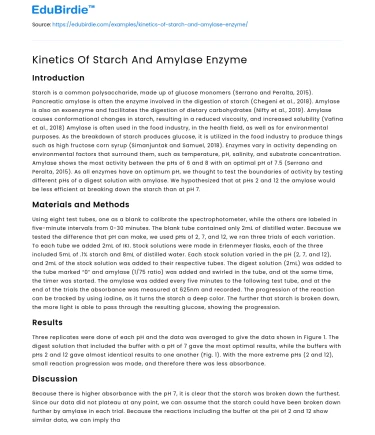Introduction
Starch is a common polysaccharide, made up of glucose monomers (Serrano and Peralta, 2015). Pancreatic amylase is often the enzyme involved in the digestion of starch (Chegeni et al., 2018). Amylase is also an exoenzyme and facilitates the digestion of dietary carbohydrates (Nifty et al., 2019). Amylase causes conformational changes in starch, resulting in a reduced viscosity, and increased solubility (Vafina et al., 2018) Amylase is often used in the food industry, in the health field, as well as for environmental purposes. As the breakdown of starch produces glucose, it is utilized in the food industry to produce things such as high fructose corn syrup (Simanjuntak and Samuel, 2018). Enzymes vary in activity depending on environmental factors that surround them, such as temperature, pH, salinity, and substrate concentration. Amylase shows the most activity between the pHs of 6 and 8 with an optimal pH of 7.5 (Serrano and Peralta, 2015). As all enzymes have an optimum pH, we thought to test the boundaries of activity by testing different pHs of a digest solution with amylase. We hypothesized that at pHs 2 and 12 the amylase would be less efficient at breaking down the starch than at pH 7.
Materials and Methods
Using eight test tubes, one as a blank to calibrate the spectrophotometer, while the others are labeled in five-minute intervals from 0-30 minutes. The blank tube contained only 2mL of distilled water. Because we tested the difference that pH can make, we used pHs of 2, 7, and 12, we ran three trials of each variation. To each tube we added 2mL of IKI. Stock solutions were made in Erlenmeyer flasks, each of the three included 5mL of .1% starch and 8mL of distilled water. Each stock solution varied in the pH (2, 7, and 12), and 2mL of the stock solution was added to their respective tubes. The digest solution (2mL) was added to the tube marked “0” and amylase (1/75 ratio) was added and swirled in the tube, and at the same time, the timer was started. The amylase was added every five minutes to the following test tube, and at the end of the trials the absorbance was measured at 625nm and recorded. The progression of the reaction can be tracked by using iodine, as it turns the starch a deep color. The further that starch is broken down, the more light is able to pass through the resulting glucose, showing the progression.
Save your time!
We can take care of your essay
- Proper editing and formatting
- Free revision, title page, and bibliography
- Flexible prices and money-back guarantee
Results
Three replicates were done of each pH and the data was averaged to give the data shown in Figure 1. The digest solution that included the buffer with a pH of 7 gave the most optimal results, while the buffers with pHs 2 and 12 gave almost identical results to one another (Fig. 1). With the more extreme pHs (2 and 12), small reaction progression was made, and therefore there was less absorbance.
Discussion
Because there is higher absorbance with the pH 7, it is clear that the starch was broken down the furthest. Since our data did not plateau at any point, we can assume that the starch could have been broken down further by amylase in each trial. Because the reactions including the buffer at the pH of 2 and 12 show similar data, we can imply that at these pHs, perhaps it was too extreme and was out of optimal range. Inferring that a pH of 7 is optimal, we would have benefited from testing pHs such as 9 and 5 to test which facilitated the breakdown of starch better. It may have showed better data had we chosen pHs closer to 7 in order to get more variable data. Human error could have contributed as we were limited on the number of pipettes, and 2mL had to be added to three test tubes at the same time to remain consistent.
Literature Cited
- Chegeni, M., Amiri, A., Nichols, B., Naim, H., Hamaker, B. 2018. Dietary starch breakdown product sensing mobilizes and apically activates-glucosidases in small intestinal enterocytes. FASEB Journal 7:3903-3911.
- Vafina, A., Proskurina, V., Vorobiev, V., Evtugin, V. G., Egkova, G., Nikitina, E. 2018. Physicochemical and Morphological Characterization of Potato Starch Modified by Bacterial Amylases for Food Industry Applications. Journal of Chemistry 1–9.
- Serrano, A., Peralta, E. 2015. The effects of temperature, pH and metal ions on alpha amylase activity of the brine shrimp Artemia salina. International Journal of the Bioflux Society 7:77-86.
- Simandjuntak, S., Samuel, M. 2018. Isolation and Identification of Thermophilic Bacteria, Producer of Amylase Enzyme, from Lake Linow, North Sulawesi. Journal of Pure and Applied Microbiology 12:543-554.
- Nifty, J., Vidyalakshmi, V., Hatha, M. 2019. Effect of pH and Salinity on the Production of Extracellular Virulence Factors by Aeromonas from Food Sources. Journal of Food Science 84:2250-2255.






 Stuck on your essay?
Stuck on your essay?

